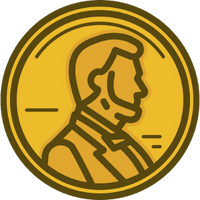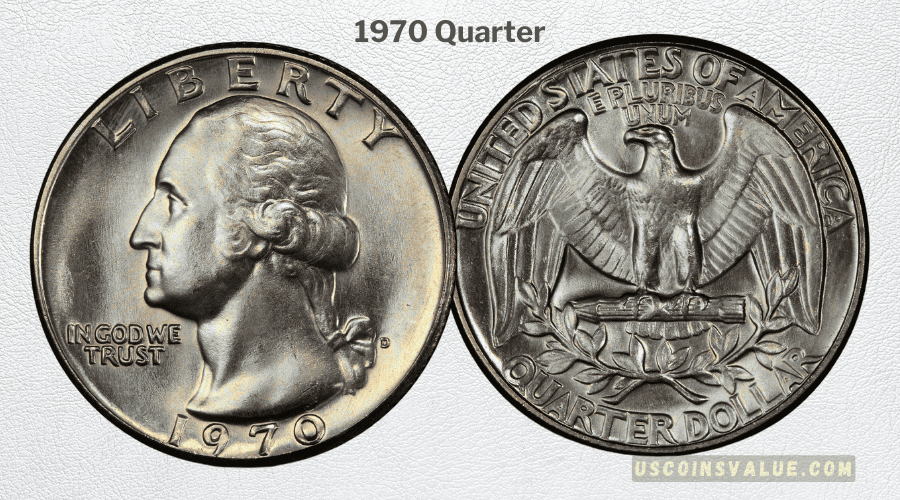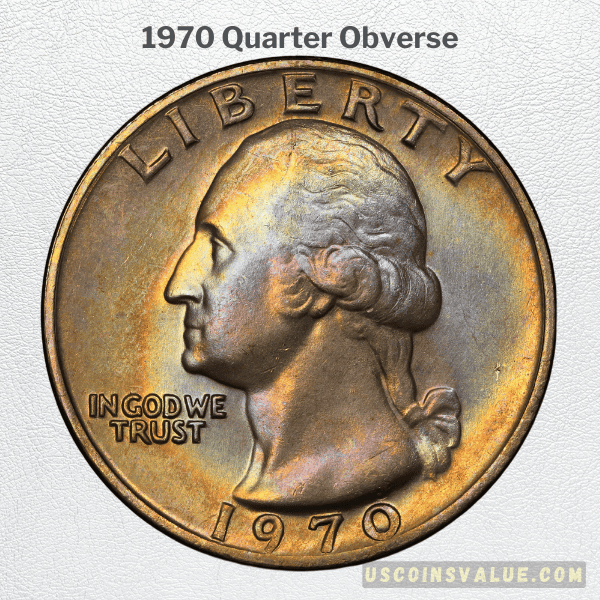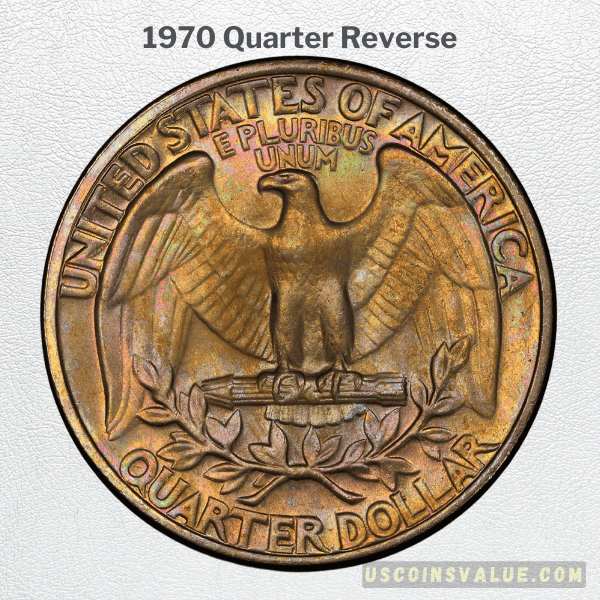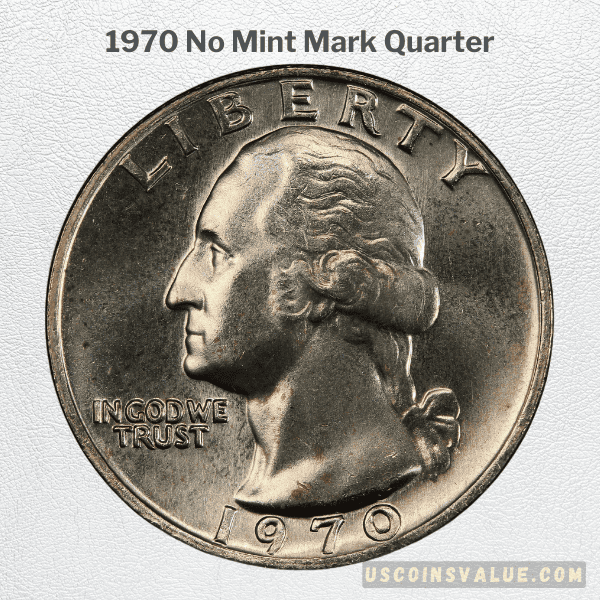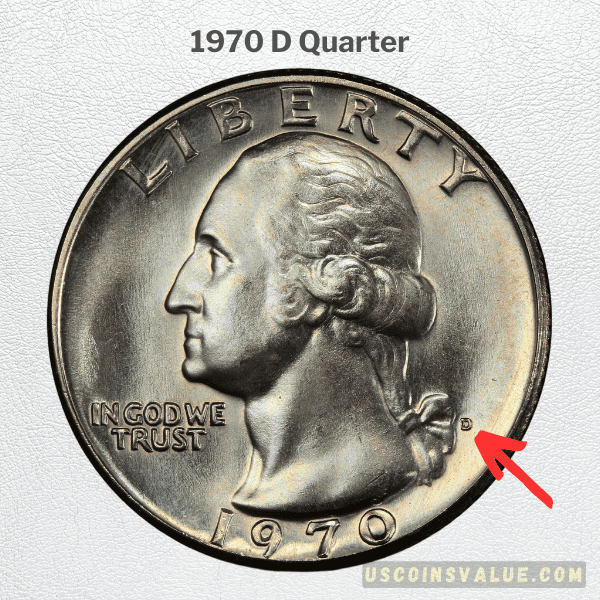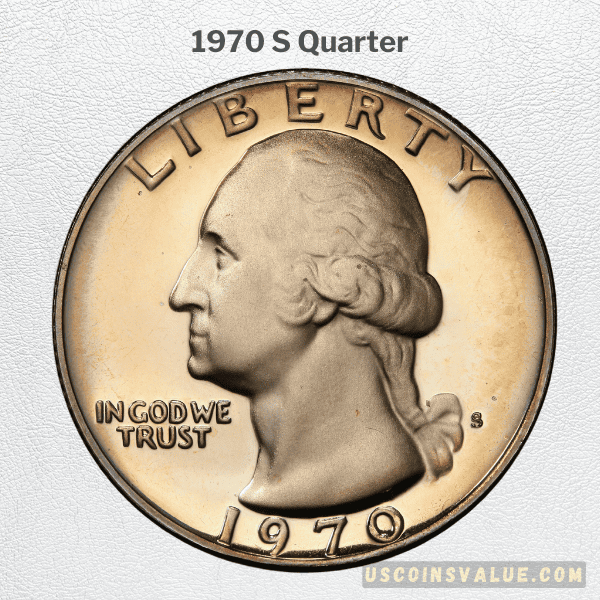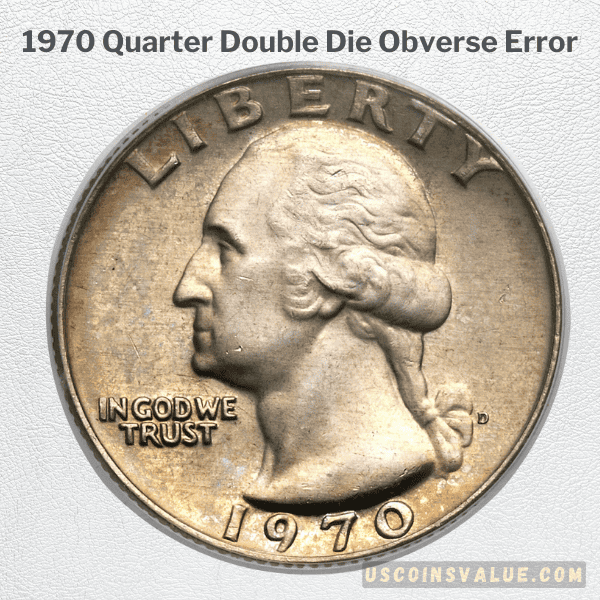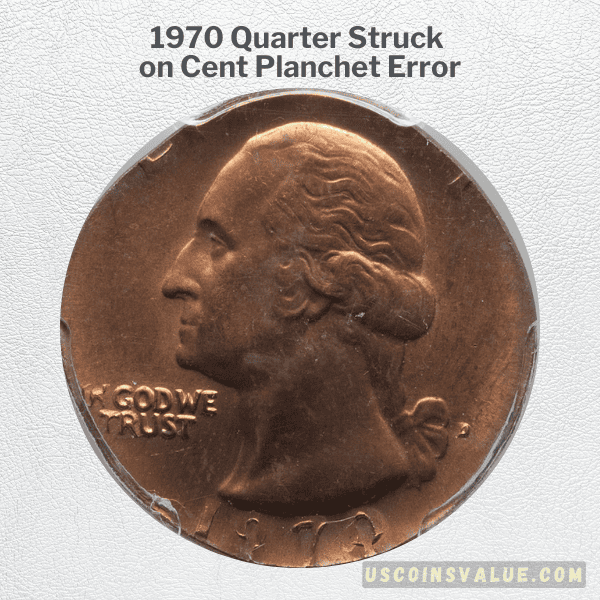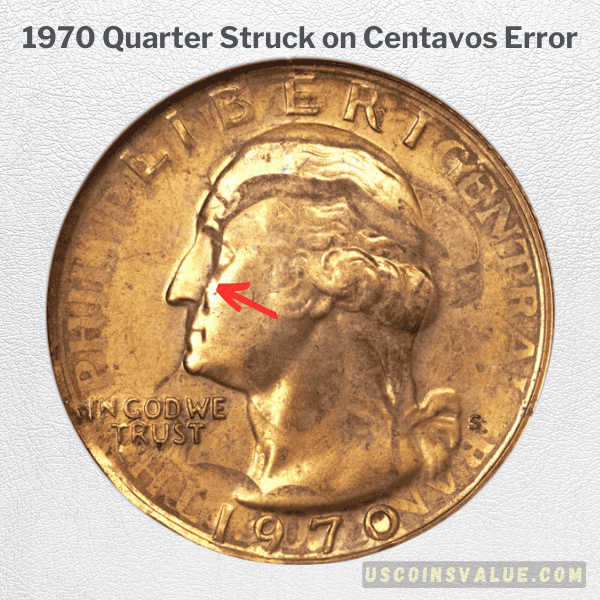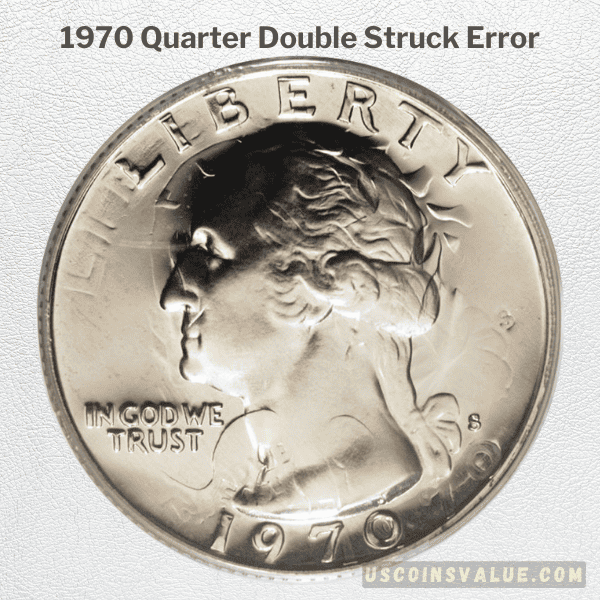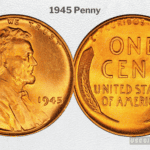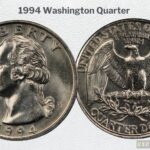If you quickly search for the 1970 quarter on Google today, you will be surprised by the number of questions people have posted.
- Is the 1970 quarter worth anything?
- What is special about the 1970 quarter?
- How rare is the 1970 quarter?
These are just but a few examples. But why the sudden interest in this American coin?
Well, maybe it’s because a 1970-S listed on eBay in 2016 recently sold for a remarkable price of $35,000. Yes, you have read that correctly: someone bagged a five-figure sum for a single 25-cent coin.
And if that’s not interesting enough, more than 20 collectors showed interest in buying the quarter.
However, this was no regular 1970 quarter. It had a unique error due to manufacturing issues at the San Fransisco mint, but more on that later.
Whether you want to add a single rare 1970 quarter or complete your Washington quarter collection, you’ve come to the right place.
Keep reading and learn everything about the 1970 quarter history, value, varieties, and more!
Understanding the 1970 Quarter
Did you know the U.S. Mint introduced the first quarter in the 17th century?
More specifically – in 1796. These quarters featured a bust of Lady Liberty on the obverse and an American eagle on the reverse.
The 1970 quarters, however, first entered circulation in 1932. At the time, the United States government was preparing to celebrate the 200th birthday of its first president, George Washington.
As a way of honoring him, the bicentennial committee established by Congress replaced the Standing Liberty Quarter with a new coin depicting Washington on the obverse. Hence, the name “Washington Quarters”.
Initially, the quarters comprised 90% silver and 10% copper. However, rising silver prices created a situation where the intrinsic value of the quarters exceeded their face value. This forced the mint to adopt a new metal composition to mitigate hoarding and increased production costs.
In 1964, the quarters adopted a copper-nickel outer layer and copper core. While this new composition made the coins less valuable, they became more durable and practical.
In 1970, Washington quarters were minted in San Francisco, Philadelphia, and Denver. In total, these centers produced over 500 million pieces, with the Denver Mint recording the highest mintage of 417,341,364.
How Does A 1970 Quarter Look Like?
Well, the 1970 quarters are no different from modern-day Washington quarters. Both feature an obverse and reverse design, created by John Flanagan–a New York Sculptor.
At the obverse sits a burst of ex-president George Washington (facing left), inspired by Houdon’s model created in 1786. Above the portrait, you can see the word “LIBERTY”.
The U.S. motto “IN GOD WE TRUST” falls to the left, while the date dominates the bottom.
On the reverse, Flanagan adopted a modernistic design depicting an eagle with its wings spread out. The bird stands on a bundle of arrows framed below by olive branches to symbolize strength and peace.
Above the eagle’s head, the engraver included the Latin motto “E PLUBRIS UNUM”, encircled by the words “UNITED STATES OF AMERICA” and “QUARTER DOLLARS”.
Additional 1970 Quarter Details
- Category: Washington Quarters
- Mint: Denver, Philadelphia, San Fransisco
- Mintage: 540,240,364
- Obverse and Reverse Design: John Flanagan
- Composition: Outer layer (75% copper and 25% nickel-clad), Core (100% copper
- Weight: 5.67g
- Diameter: 24.3 mm
- Edge: Reeded
- Thickness: 1.75mm
- Face Value: $0.25
Are The 1970 Quarters Worth Anything?
As highlighted earlier, the Washington quarters were minted in millions in 1970 between three minting facilities. Therefore, they are not rare – you can easily find them in circulation.
You can buy uncirculated pieces from your local coin shop or online marketplaces like eBay.
Of course, some quarters are worth far more than their face value of 25 cents, as you will see later in the article. But for now, let’s focus on the value of the regular 1970 quarter.
Usually, its value is influenced by several factors, including mint marks, conditions, and errors. For example, quarters struck in the Philadelphia Mint in 1970 cost no more than their face value.
However, pieces from Denver and San Francisco mints might have a higher value depending on their condition.
In terms of condition, a circulated 1970 quarter is worth anywhere from $0.5 to $1. But as the quality of the coin improves, so as its value.
So, if you have discovered an uncirculated sample from your grandmother or grandfather’s coin stash, you may get $20 or more for it. However, examples with a high grade (mint state) could bring in as much as $2,160.
The table below summarizes the value of the different 1970 quarters minted in Denver, Philadelphia, and San Francisco mints.
| 1970 Quarters Value Chart | |||
| Mint Mark | Circulated | Uncirculated | MS 60+ |
| 1970 “no mint mark’ Washington Quarter | $0.30 – $1.00 | $5.00- $10.00 | $15.00 – $245.00 |
| 1970 “D” Washington Quater | $0.30 – $1.50 | $5.00 – $10.00 | $20.50 – $110.00 |
| 1970 “S” Washington Quarter | $0.30 – $1.40 | $5.00 – $20.00 | $30.00 – $1000.00+ |
Now, let’s learn about the varieties of this American quarter:
1970 “No Mint Mark” Quarter Value
Unlike the other mints, the Philadelphia Mint didn’t produce the largest amount of Washington quarters in 1970. That title goes to Denver Mint, which produced around three times more than Philadelphia.
On average, the Philadelphia facility struck around 136 million quarters. Coins from this center do not have a mint mark, so you can easily distinguish them from samples from other mints.
The value of the 1970 “no mint mark” quarter depends on its condition. Generally, a circulated 1970 “no mint mark” quarter in good to excellent condition can sell anywhere from $0.30 to $1.00.
However, some rare pieces in mint state can fetch between $10 to $2,000+ on the open market or auctions.
Here are a few examples of 1970 “no mint mark” quarters that sold for an impressive price:
| Grade | Price | Auction House | Date |
| MS 64 | $15.00 | David Lawrence RC | Nov – 2007 |
| MS 65 | $15.00 | David Lawrence RC | Dec – 2005 |
| MS 66 | $86.00 | Heritage Auctions | Nov 2007 |
| MS 66 | $54.00 | Heritage Auctions | Feb – 2007 |
| MS 67 | $875.00 | Heritage Auctions | Jan – 2014 |
| MS 67+ | $1,998.00 | Heritage Auctions | Jan – 2014 |
| MS 67+ | $2,115.00 | Heritage Auctions | Now – 2014 |
| MS 67+ | $2,160.00 | Heritage Auctions | Jun – 2019 |
1970 “D” Quarter Value
Most regular strike 1970 quarters from Denver are worth only their face value or slightly more. They were minted in millions, which makes them super common in circulated and uncirculated conditions.
But this doesn’t necessarily mean all Denver quarters from 1970 are not valuable. While you can buy them for $1 or less, if you find a well-preserved sample with clear details and mint luster, expect around $70 to $110.
Of course, a higher grade means a higher value. So, for a 1970-D graded at MS 67 or 68+, you can get $456 and $2,160, respectively. And by luck, if you get an MS69 1970-D, we could be looking at $15,000 or more.
| Grade | Price | Auction House | Date |
| AU 55 | $58.00 | Heritage Auctions | Dec – 2014 |
| MS 63 | $2,640.00 | Great Collection | Aug -2014 |
| MS 64 | $174.00 | Heritage Auctions | Jul -2022 |
| MS 65 | $19.00 | David Lawrence RC | Apr – 2022 |
| MS 66 | $1,540.00 | Great Collections | Aug – 2014 |
| MS 67+ | $504.00 | Stack’s Bowers | Nov – 2019 |
| MS 68 | $2,115.00 | Heritage Auctions | Jan -2017 |
| MS 68+ | $3,960.00 | Heritage Auctions | Dec – 2022 |
1970 “S” Quarter Value / Proof Coins
Like the years before, the San Fransisco mint only struck proof quarters in 1970. It produced a total of 2,632,810 coins with the “S” mint mark on the right flank of Washington’s portrait.
The 1970-S quarters are easy to identify since they were struck on unique planchet, which gives them a glossy finish that collectors and coins enthusiasts love.
Because of their low mintage, 1970-S 25 cents have a higher value compared to pieces from the other two mints. However, don’t expect to make a fortune out of these pieces unless you have a piece graded on MS 66 or higher or designated as Cameo (CAM) or Deep Cameo (DCAM).
Case in point, this 1970-S Cameo quarter grades at PR 66 sold for around $1,553 at Heritage auctions, which is a significant price for a 25-cent coin. For a deep cameo 1970-S quarters, you can get upwards of $2,760 and above.
But why do these coins sell for so much?
It’s simple! They have a higher contrast coupled with strong details, an ice-like design, and a glossy finish. Add a minting error in the equation and the coin can bring in thousands of dollars.
A good example is the 1970-S quarter struck on a 1941 Canadian quarter planchet that sold for a whopping sum of $35,000 on eBay.
The table below offers you a summary of a few 1970-S examples that fetched an interesting price in the open market:
| Grade | Price | Auction | Date |
| PR 67 | $55.00 | Heritage Auctions | Jul – 2022 |
| PR 68 | $109.00 | Heritage Auctions | Jan – 2007 |
| PR 68 | $127.00 | Great Collections | Jun -2011 |
| PR 69 | $978.00 | Heritage Auctions | Feb – 2007 |
| PR 69 | $1,380.00 | ||
| PR 69 | $2,760.00 | Heritage Auctions | Nov -2007 |
| PR 69 DCAM | $2,400.00 | Stack’s Bowers | Jul – 2009 |
How Can You Tell If A 1970 Quarter is Rare?
Numismatics are always looking for rare collectibles, but how do they identify these items?
In the world of coins, there are several ways to identify a rare piece. First off, you can check for low mintage. As we have established, millions of 1970 Washington quarters exist out there, both in circulated and uncirculated conditions. So, this factor doesn’t count.
Secondly, you can inspect the condition and grade of the coin. Based on this method, we have identified several unique 1970 quarters that have fetched high prices in the market over the recent years.
The third and arguably the best method is looking for minting errors. These errors might occur at any stage of the manufacturing process and are often caused by human or machine issues.
Minting errors increase the value of coins significantly, especially if they have a high grade. But keep in mind not every error will demand a premium. Some are super common and have little to no effect on the overall value of the quarter.
That said, here are a few 1970 quarter rare errors you should watch out for:
1970–D Quarter Double Die Obverse Error
The double die obverse is a fairly common error but still sought out by collectors and coin enthusiasts alike.
It’s a minting error, which occurs during the production process when the die strikes the design details twice onto a coin. As a result, the coin appears to have a doubling of images and other design aspects.
For this 1970–D Washington quarter, you can observe the doubling of the word “LIBERTY”. It sold for around $2,875.00 in 2012 at Heritage Auctions.
1970–D Quarter Struck on Cent Planchet Error
As the name implies, this mint error occurs when a planchet intended for cents is inserted into the blanking press.
If the mistake goes unnoticed, the cent planchet often gets struck into quarter coins. The result is the 1970–D quarter struck on Cent Planchet.
While this coin might sometimes look like the Washington Quarter, it has a weak peripheral detail and some flatness at the high points of the design. Also, it assumes a distinctive tone that resembles the cents.
This example brought in around $1,260.00 for a collector in 2020. However, the high price might also be attributed to the mint state condition of the quarter.
1970 Quarter Struck on a Philippine 25 Centavos
The U.S. Mint was famous for producing high-quality coins for other countries. So, it’s no surprise that blank metal sheets used for the Philippine 25 Centavos were struck with the Washington Quarter design.
In 1970, two coins with such error appeared: the 1970–S quarter graded at PR64 and the 1970 -D quarters graded at MS65. These quarters fetched $4,600 and $930, respectively.
1970-S Double Struck in Collar, Clashed Dies Error
Last but not least, we have the double stuck and colliding die error. This captivating error results in a valuable coin that could fetch hundreds, if not thousands, of dollars. You don’t believe us! Check out this 1970-S coin with PR66 grade, which demanded a high premium of $1,989.50 in 2007.
Like all proof coins, this Washington Quarter was struck twice, but the obverse dies rotated clockwise (roughly 20 degrees) between the strikes.
On top of that, the dies collided without a planchet in between, which left the impression of one die on the other. So, when the coin was struck, the clash marks appeared on its surface.
In the example above, the clashed dies left an impression of “E” from “E PLUBRIBUS UNUM” on the obverse just above the 1 and 7 in the date.
Closing Thoughts
There you have it, the complete review of the 1970 Washington quarter. But before we go, let’s summarize a few things we’ve learned.
The 1970 quarter is an intriguing piece, but it’s not as rare as many people believe. The only reason why the coins might appear scarce is because the U.S. Mint removed them from circulation. However, you can still find several coins in circulation to date.
In terms of value, these Washington quarters are worth their face value or slightly more. So, it’s unlikely that you will find a high-value piece in your change jar. However, it could be worthwhile to sift through your change and check out for distinct flaws or traits.
You never know! Maybe a unique and valuable piece like those listed above is lurking around.
